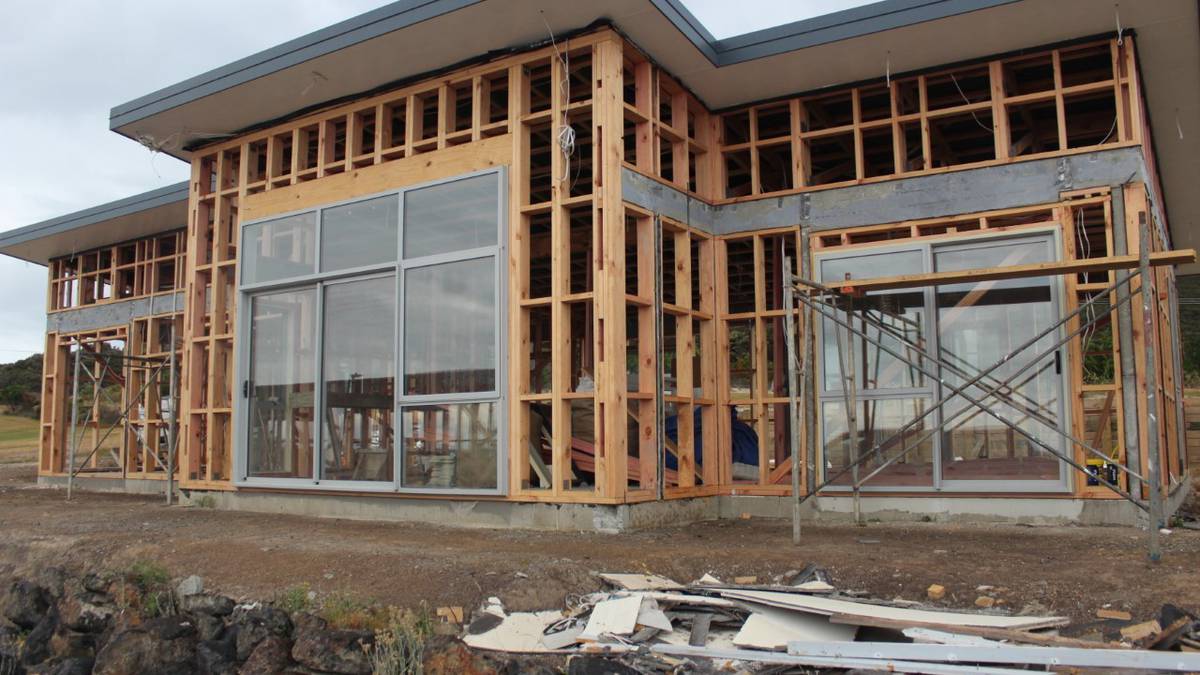Shaveran Naicker has had to redo his house after removing what he claimed were defective wall panels supplied by Global Fibre8. Photo / Supplied
A Northland man has taken the Far North District Council to court for approving an allegedly faulty building material that forced him to demolish his home and rebuild.
More than five years of dealing with
the problem while running a business and a family at the same time have taken their toll on physiotherapist Shaveran Naicker, who said he has so far spent more than $600,000 on various legal and engineering costs.
The physiotherapist and owner of Top North Physiotherapy in Kaitaia is resigned to the fact he may never recoup the money and the next lot of expenses is legal costs for a seven-day trial in the High Court, tentatively set for May next year.
Naicker has filed a claim against FNDC regarding faulty K3T wall panel system sold by Auckland-based Global Fibre8
He is claiming special damages of $381,177, consequential losses of $67,043, general damages of $30,000 as well as interest and costs.
FNDC general manager district services Dean Myburgh said the council has communicated extensively with the Naickers and their lawyers about the claim.
“The council does not accept their position and has filed a defence with the High Court. Accordingly, we cannot comment further on the court proceedings.”
In 2018, the High Court ordered Global Fibre8 (GF8) to pay more than $84,000 in damages to Far North couple Randolph and Karen Urlich.
The court ruled GF8 breached the Fair Trading Act by saying the K3T was a tested and approved building material in New Zealand when it was not.
The Urlichs sued FNDC, GF8, and their builders but a settlement was reached with all except GF8.
/cloudfront-ap-southeast-2.images.arcpublishing.com/nzme/UTUOJ4QNTIYXOHAQ7Q7UL4H27Q.jpg)
Photo / Myjanne Jensen
Naicker decided to use the K3T product in his new house at Whatuwhiwhi in early 2015 and went to Auckland to discuss the product with GF8 representatives.
His house was built in 2016 but in January 2017 when it rained, he said the whole house started to crack.
“The same thing happened to the Urlichs before us. We were given notice to fix and an engineering report was asked which we did. We had to demolish every single wall, redo the internal and external Gib, replumb and repaint the house.”
He’s had to choose a different cladding and the house was finished in October 2019. What followed was 600 to 700 emails between him, FNDC, GF8 and the lawyers.
“The whole thing has been a huge stress. I used to be a half marathon runner but have since developed heart problems dealing with this while running a business, looking after my family, and sorting out legal issues.
“There’s no end in sight … it just goes on and on. I wish I had never heard of that product. I relied on the system to tell me it’s okay to carry on,” Naicker said.
In a separate proceeding, the District Court last month fined GF8 $280,000 and its shareholder Tangi Tuake $80,000 and ordered him to pay reparation of $120,000 to eight consumers for their loss, including the cost of remediating their properties.
Three consumers are from Northland.
The judgment followed charges filed by the Commerce Commission in July 2019 against GF8 and Tuake after it received complaints the duo were claiming K3T had a New Zealand CodeMark certification.
/cloudfront-ap-southeast-2.images.arcpublishing.com/nzme/JYFZNUB6JVTRIBUJ56HK5VDMIA.jpg)
Judge Kevin Phillips said there was no doubt in his mind Tuake and his company knew what they were saying was false.
“The K3T wallboard did not have a New Zealand CodeMark and that any certification it did have was incapable of certifying compliance with the NZBC. That could only be done through a New Zealand CodeMark, which K3T has never had.”
Commerce Commission chairwoman Anna Rawlings said building a home was a substantial investment and for most people, it was likely to be their most significant asset.
“They should be able to rely on information they are provided about approvals or certifications of building products and methods. Businesses must ensure any claims they make are accurate and can be substantiated.”
K3T is a magnesium oxide/fibre cement wall panel system used externally and internally in the construction of houses and commercial buildings. It is made from pre-fabricated panels that are assembled onsite to form walls.
K3T was marketed as a cheaper and quicker alternative building method and a solution to the rising costs of housing in New Zealand.
On its website, Global Fibre8 represented K3T as “practical, durable and affordable”, and promised “reduction of cost through construction time saving, less trade and less materials”.




